If you only know about dwarf cacti of the deserts, then you need to see the forest for trees. Yes, our earth is full of undiscovered wonders beyond anyone’s comprehension. So big always looks awe-inspiring, and in the same manner, large-sized entities fascinate people.
A fantastic variety of tall cacti exist in different parts of the World that we cannot recognize. Tall cactus plants show slower growth and are incredible drought and heat-tolerant plants.
Saguaro and Mexican giant cardon cactus increase in size only one inch in 10 to 15 years. They take around 250 years to reach puberty.
Tall cacti are garden gems that enhance outdoor beauty as fences, hedges, and borders. They also accent indoor patios, terraces, lawns because they do not grow very fast. You can enjoy these carefree plants for years without looking back. When they grow in size, shift the larger specimens outside immediately.
To surprise your visitors with wonders, the addition of tall cactus plants will do a great job. Thus, these ten extraordinary tall cactus varieties can revive your yards and landscapes.
10 Amazing Tall Cactus
1. Echinocactus grusonii (Golden Barrel Cactus)
It is a famous garden cactus of Central Mexico and the U.S with a “mother-in-law’s cushion.” Golden barrel cactus with 35 ribs spreads in clumps of lemon green spherical to ovate stems.
It reaches a height and width of 3.5 feet. Clusters of golden overlapping spines emerge from the ribbed stems. Golden barrel cactus plants bear milky white soft hairs at the top of their apex. These are the miraculous compass for desert wanderers due to their Southwest-facing position.
Care and Maintenance
Echinocatus grusonii shows extreme slow growth that prefers full sun. Like all desert plants, it is a great low water plant and can withstand drought for a long time. Feeding these cacti with potassium fertilizer will result in healthy growth in summer.
It can grow with USDA zones of 9 to 10. Regular pruning is mandatory as it grows in clumps. Thus, overcrowding of offsets can make this plant ugly-looking.
Bloom time
These cactus plants bloom outdoors in full sunlight and become non-flowering plants indoors. At maturity, the top crowns of golden barrels form 2 inches wide short yellow flowers in early summer.
Where to plant
Golden barrels are outstanding ornamentals for large containers, rock, desert, and Mediterranean gardens.
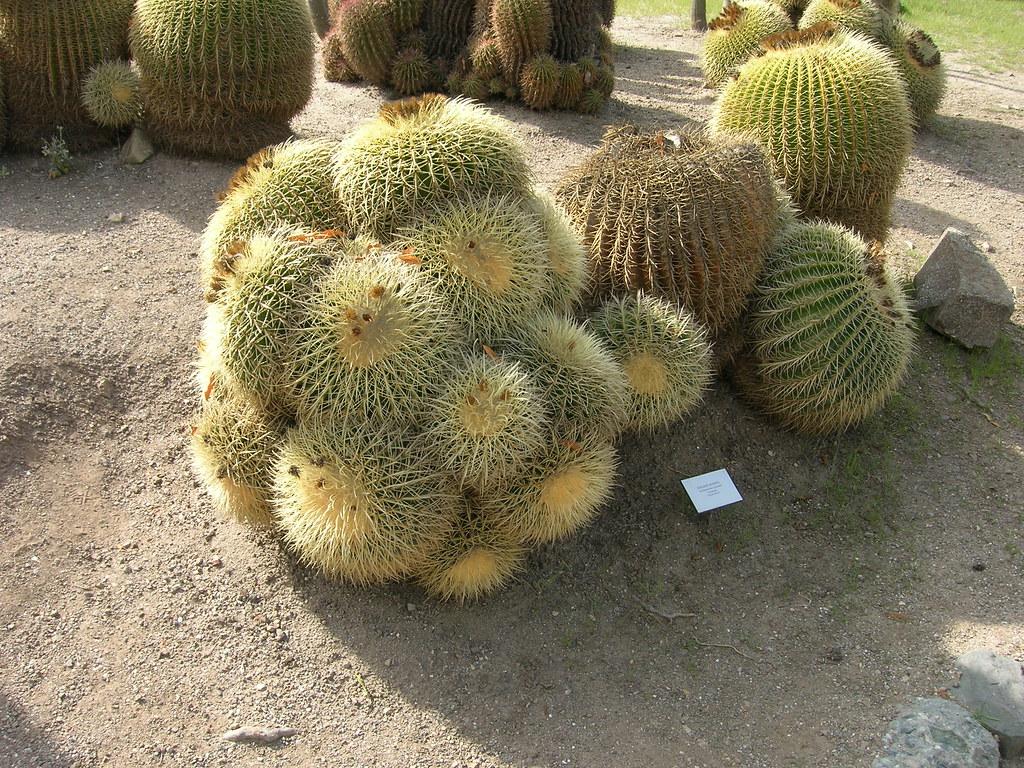
Pachycereus schottii (Totem Pole Cactus)
Pachycereus schottii propagates on the sloppy hills and the deserts of California, Mexico. These unusual cacti plants are slow-growing trunkless. They form light to dark green up to 15 feet tall cylindrical stems.
Stems with branched bases may be sleek or rough, consisting of 6 to 10 ribs. Smooth stems bear warts, and only huge specimens grow with white short and long curved spines.
Care and Maintenance
Pachycereus schottii does not need much attention and maintenance. These are terrific drought-resistant cacti that can store water for a prolonged period.
All-purpose potting soil like sandy soils will be the best for their development. About 6 to 7 hours of direct sunlight is a must for them and water only after 8 to 12 days in summer. USDA hardiness zones for totem pole cactus are 9a to 11b.
Bloom time
The distinct feature of the totem is to produce flowers only at night and stop blooming during the day. Conical-shaped pinkish-green short showy flowers appear on uppermost stems from April to September.
Where to plant
Totem pole cactus is a great container plant, rockery gem, and landscape ornamental.

Myrtillocactus geometrizans (Blue Myrtle Cactus)
Myrtillocactus geometrizans show moderate growth in the tropical deciduous forests of North-Southern Mexico.
The young plant is columnar but forms small, robust tree-like trunks at maturity. Lantern-shaped stems with 3 cm deep ribs can reach up to 12 feet high and 10 feet wide. 5 to 9 short black spines and bluish-green evergreen leaves appear from the ribbed stems.
Care and Maintenance
Young blue myrtle cacti need partial sunlight for thriving. Mature specimens prefer full sun for average growth. Grow indoors as these large columnar cactus plants are not
frost-resistant. Clay pots with drainage holes and rich soils will promote the development of these cacti. These cacti species exhibit active growth with the temperature of 10 C and USDA zones of 9a to 11b.
Bloom time
Blue myrtle gives yellow-green, 3 to 4 cm long, tubiform, and aromatic flowers from spring to early summer.
Where to plant
The best places to cultivate Myrtillocactus geometrizans are rockeries, deserts, and coastal gardens. Hence, blue myrtle cactus plants can be noticeable gems when grown in larger pots indoors.
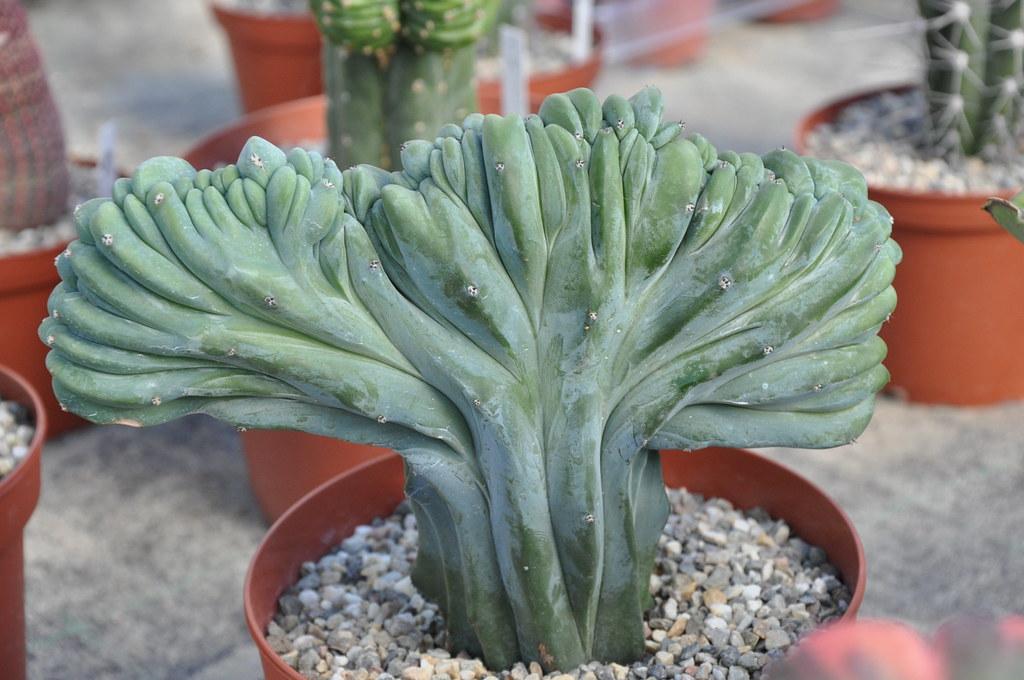
Austrocylindropuntia subulata (Eve’s Needle Cactus)
Eve’s needle invades the roadsides, riversides, and grasslands of Ecuador, Peru, and Bolivia. It has an unusual shape and can grow 12 to 13 feet high and 4 to 5 feet wide. Eve’s needle consists of dark green tubular 5 inches stem with 2.5 feet long and 3 inches wide joints.
Mature plants bear awl-like green 5.5 inches long leaves and 3 inches long bright yellow spines.
Care and Maintenance
Eve’s needle cactus incredibly survives the drought and different ranges of temperatures. It is a low water plant and prefers full bright light for thriving. Clay pots with drainage holes and humus-rich soils always work great for these cacti. USDA zones are 9a to 11b. Although this tall cactus requires low-upkeep.
Try to keep the plant neat and clean by regular pruning. Cut the unnecessary stems and leaves to design the plant. Also, remove the faded withered flowers and ripe fruits. Even so, be careful of sharp golden-yellow spines.
Bloom time
Eve’s needle gives orange-red 4 to 5 inches long cupped showy flowers in mid-spring or early summer.
Where to plant
A. subulata is not a very large cactus but slightly larger than short-sized cacti. Thus, it can be an ideal addition for rock gardens and container houseplants.
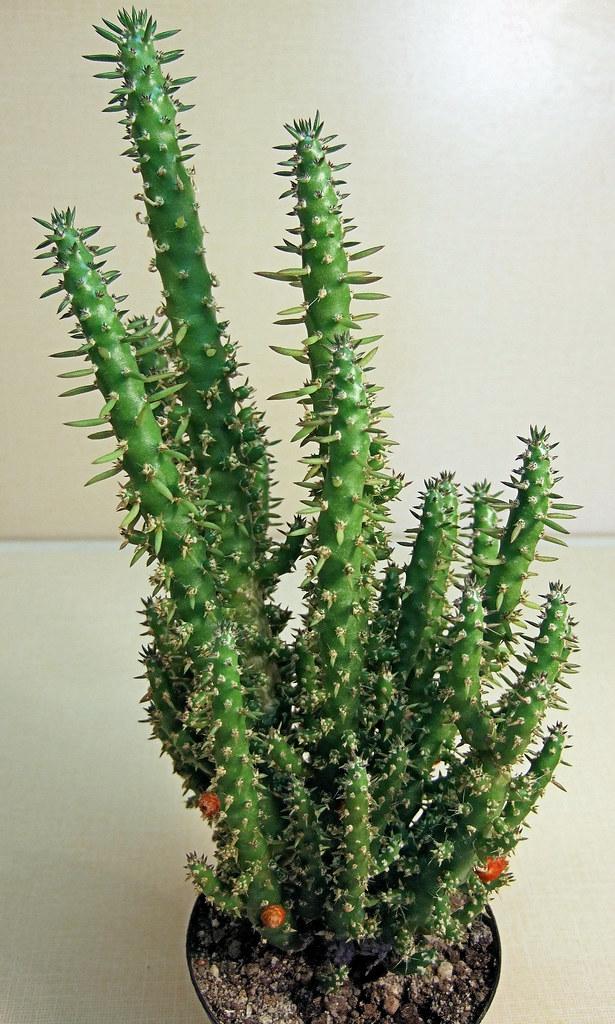
Related: Ten Extraordinary Types of Tall Cactus Can Revive Your Yards and Landscapes
Euphorbia lactea (Candelabra Cactus or African Milktree )
Euphorbia lactea comes from the arid natural habitat of Africa, India, Srilanka, and Thailand. These are tree-like deciduous spiny large cactus plants that grow up to 15 meters tall. Upright stems bear blackthorns and spotty crested branches with white outlines.
Candelabra cactus produces small, ovate whorled leaves in spring, but leaves fall off quickly.
Care and Maintenance
Candelabra lactea needs dry climates with direct and bright indirect light for growth. These giant cacti have large fleshy pads to store enough water. These fleshy pads with stored water helps them to survive the desert-like conditions.
Follow the wet and dry method for summer watering, but there is no need for more water in winter. It cannot withstand frost, and hardiness zones for its growth can be 10a to 11a.
Bloom time
Candelabra cactus shows bright yellow 1 inches long mottled flowers. They bloom in early summer or spring.
Where to plant
These cacti best fit hedge specimens, hanging baskets, and container indoor cacti.

Pachycereus marginatus (Mexican Fence Post or Organ Pipe Cactus)
Organ pipe cactus is native to the warm, arid deserts of Southern-North Mexico. It is a deep green slow-growing giant columnar cactus. It can reach 15 to 20 feet in height in wild habitats.
Mature Mexican fence post cactus form basal branches and rough upright stems with 3 to 7 ribs. Ribbed stems resemble old-aged pipes. P. marginatus bear light yellow 1 to 2 central spines and 4 to 10 radial brown spines.
Care and Maintenance
You don’t have to worry too much about this cactus; you may even forget this plant for years. Like other cacti, the Mexican fence post cactus is a low water plant but loves full sun for thriving.
Grow this cactus in deep terra cotta pots filled with well-drainage clay sandy or silty soils. Organ pipe cactus can survive temperatures 60 to 80 F degrees. USDA zones can be 9b to 11b.
Bloom time
The uniqueness of the organ cactus is to produce funnel-shaped flowers after sunset. Furthermore, these organ cacti give 5 cm long pinkish-green stunning flowers in spring.
Where to plant
Mexican fence post cactus offers many creative ideas for outdoor and indoors. For example, if you want to hide ugly destructive patio corners and walls. Thus, these can be unique indoor cacti for this purpose. You can also use organ pipe cactus to create nautical-themed fences in your gardens.
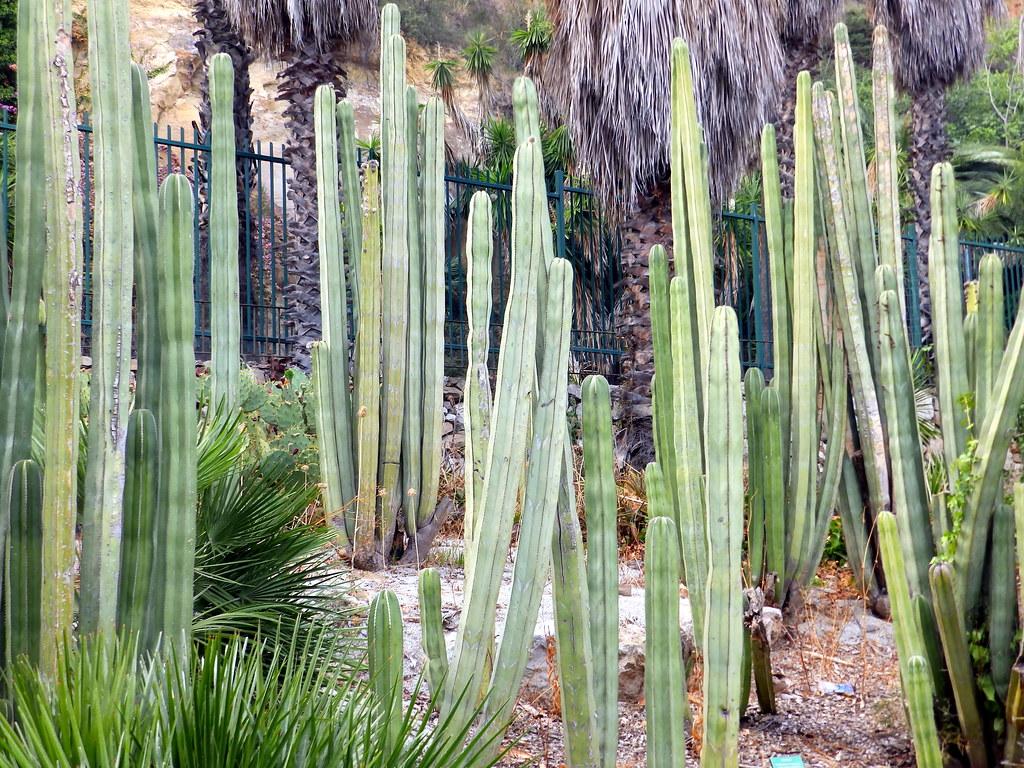
Carnegiea gigantea (Saguaro Cactus)
Carnegiea gigantea is low-grower tree-like columnar cacti that can live 200 years. It is a giant cactus of Arizona’s Sonoran desert that propagates in South-Eastern California. Saguaro cactus can reach up to 70 feet in height with a 3 feet ribbed stem.
Some saguaro cacti develop branches with growing age, and some are branchless.
They produce one large 4 to 5 feet deep taproot different from the primary roots. Stems bear rugged woody ribs and 3 inches long pointed protective spines. Saguaro is famous for its woody ribs that help build roofs, furniture, and fences. It is also a food and shelter for wild animals and birds.
Care and Maintenance
Because of its sluggish growth, Saguaro is an easy to look after and maintenance-free tall cactus. Although, direct or bright indirect light is mandatory for their phenomenal growth. It can be beautiful indoor addition.
Saguaro is not frost-tolerant and cannot survive temperatures below 60 degrees centigrades. They can be healthier in all-purpose well-drained soils with less water. They do not need fertilizers but dilute fertilizers will always promote growth. USDA zones must be between 8a to 11b.
Bloom time
At 35, Saguaro cacti give nocturnal 5.5 inches long white flowers from March to June. Saguaro cactus blooms throughout its life.
Where to plant
Saguaro cactus is a king of deserts. It is natural outdoor giant cactus and can be the best choice for heated greenhouses. These well-known cacti are most suitable for garden centers, national parks, and museums.
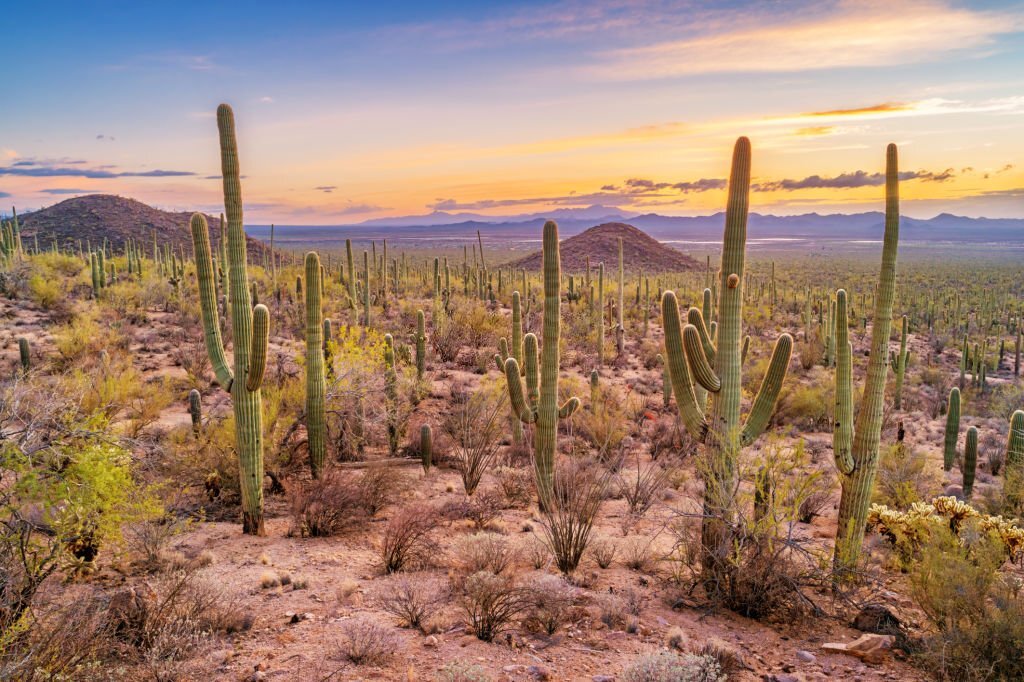
Related: Solving the Dilemma Why Cacti are Not Trees and What Makes Them Plants
Pachycereus pringlei (Mexican Giant Cardon Cactus)
Pachycereus pringlei is an enormous tree-like cactus with up to 65 height and 3 feet wide trunk. Its popularity comes from the arid areas of West-Northern Mexico or North America. Mexican giant cardon cactus can stay alive for over three hundred years.
This giant cactus forms ribbed stems, upright branches, and shallow roots. It provides the appearance of a saguaro cactus. Yet, it has a different frost resisting ability than a saguaro.
Care and Maintenance
These giant cacti are miraculous because they can grow even without soil and water. It allows you to stay aw for years without worrying about it. Though it loves full sun, try to plant it in places where plenty of light reaches. The ideal temperatures for this cactus can be 30 to 50 F degrees. Hardiness zones must be between 9a to 11b.
Bloom time
Mexican giant cardon large cactus plants bloom at night. It produces 3.5 inches long large white flowers in spring.
Where to plant
Because of low water demand, the Mexican cardon cactus best fits succulent gardens. Besides, it is low-maintenance and easy to manage the indoor plant.
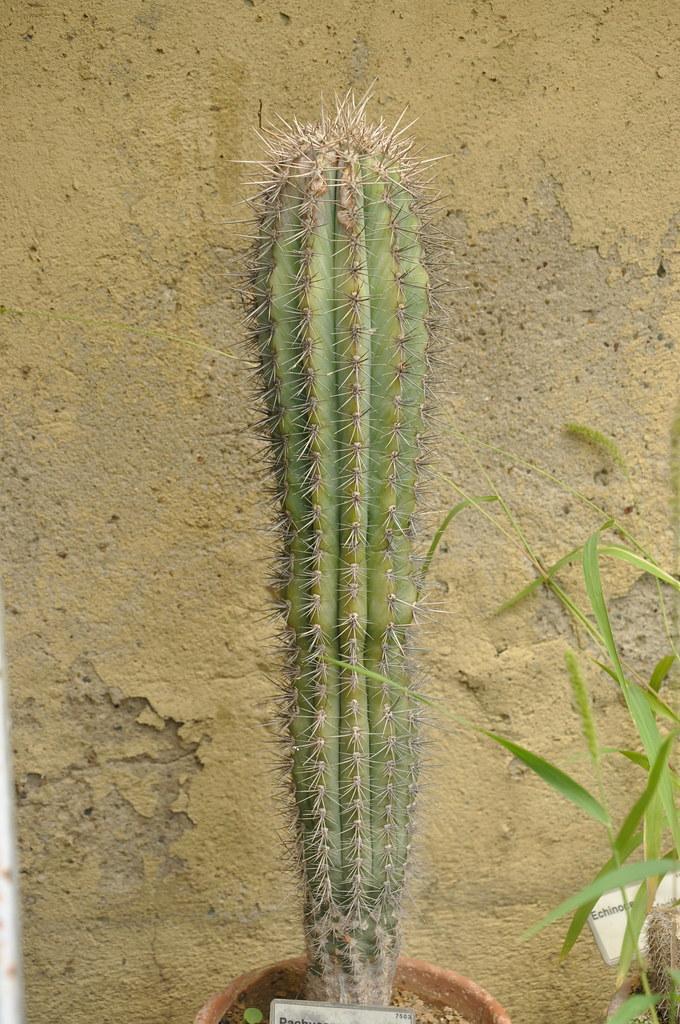
Euphorbia baioensis (Baioensis)
Baioensis is a shrubby centipede-looking annual cactus born in Kenya’s warm desert. Young plants give rise to 35 cm inches long and 3 cm wide stems with basal branches.
Stems may be upright or prostrate, columnar, green to grey, which carries 7 to 10 ribs. Ribbed stems bear clusters of 1.5 cm long grey spines with sharp red edges that turn black with maturity.
Care and Maintenance
Euphorbia baioensis is one of the great desert survivors. It continues to live without water for years. It prefers full sun to partial shade for robust growth.
If you want to grow indoors, place these cacti on south-east-facing windows. They do not demand high nutrient potting mix soils and can even withstand infertile soils.
Fertilizers always play a vital role in promoting growth and development. Feed baioensis with diluted cactus fertilizers twice a month during growing months.
They do not demand repotting every year, but they grow larger, shift them to larger pots or containers. They can survive only with temperatures 30 to 50 F degrees. Expected USDA hardy zones are 10a to 11b.
Bloom time
Euphorbia baioensis blooms in summer or spring and gives small light yellow flowers.
Where to plant
The best places to cultivate baioensis can be outdoor gardens and mountainous landscapes.
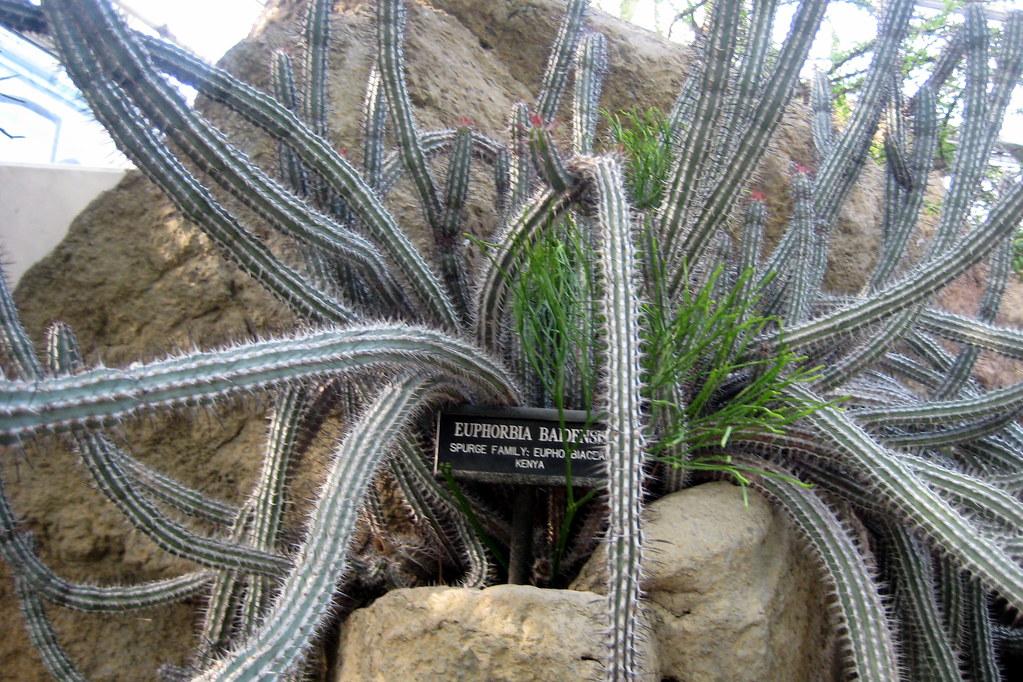
Acanthocereus tetragonus (Fairy Castle Cactus)
Fairy castle cactus propagates sandy coastal areas of West Indies and Central-Northern America. It has prostrate or curved deep green stems with clumps of castle turrets like branches.
It shows slower growth and can achieve a height of 6.6 feet in diameter. Each part of this cactus is pentagonal. It consists of 3 to 5 sharp-pointed ribs and clusters of 8 white spines.
Care and Maintenance
It is effortless to handle fairy castle cactus as it is a maintenance-free plant. Like other cacti, cultivate it in full to partial sunlight. Try to follow wet and dry methods for watering.
Clay pots with drainage holes filled with potting mix soils will encourage its growth. Temperature ranges must be between 30 to 50 F degrees. USDA hardy zones are between 10a to 11b.
Bloom time
Fairy castle cacti show night flowering and do not bloom during the daytime. Flowers are 12 to 20 cm long, white to yellow, and fragrant from fall to summer.
Where to plant
Fairy castle cactus cannot tolerate frost. Thus, growing it as a container plant inside can secure this plant. Buying this cactus plant from the online garden and grocery stores can save your time and effort. It is a famous, most demanded indoor cactus in today’s modern age.

Frequently Asked Questions
Which cactus type grows very tall?
Scientifically called Carnegiea gigantea, Saguaro is the tallest cactus in the United States. This arboreal cylindrical cactus is a slowdown in growth that can reach 45 to 60 feet high in favorable conditions.
Its life span can be more than 200 years, and it only grows to half an inch in size after 10 to 12 years. Saguaro produces snowy-white scented flowers in spring after a long period of seventy years.
What to do with the tallest cactus?
Some cacti grow very slowly, and some grow very fast. Jungle cacti are the tallest succulents that can occupy any area very quickly. Therefore, you need to cut some large additional parts of the tallest cactus to provide a neat and clean view.
Doing so can give you plenty of space to grow other plants in your gardens and homes. Moreover, Regular trimming of plants will result in healthier growth and more blossoms. You can move and position normal-sized plants anywhere in houses without any hassle.
How do you take care of the fairy castle cactus?
Fairy castle cactus (Cereus tetragonus) is a sluggish-growing and tall cactus of Central America and the United States. The marketed name “fairy castle” indicates its attractive curved turret-like branches about 6.6 feet long. It is easy to look after outdoor cactus with the USDA hardy zones 10 to 11.
The caring and propagation of fairy cactus are similar to that of other succulents. All you need to do is follow the instructions below:
- Fairy castle is a sun-loving plant and prefers full sunlight for its robust growth.
- Grow this cactus with humus-rich gritty soils like sandy, loamy soils
- Always choose glassless brick pots to grow this cactus because these pots facilitate the process of evaporation
- Follow the wet and dry method to water fairy castle cactus. This cactus requires very little water in winter
- Feed this cactus with good fertilizers when it starts growing again
What tall cactus variety did you like? Also, check out our other articles:
18 World Famous Yellow Cactus Varieties for Homes and Gardens







